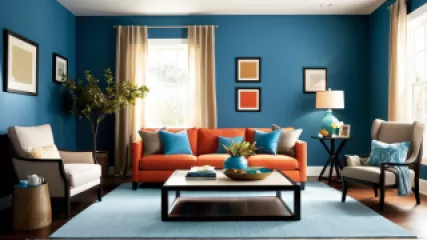Choosing the Right Colors for Your Home: A Step-by-Step Guide
When it comes to creating a harmonious and inviting living space, color plays a crucial role. The psychology of color in interiors goes beyond mere aesthetics; it can significantly impact our mood, emotions, and overall well-being. With the right color choices, you can create a space that promotes relaxation, boosts energy, or enhances focus. In this step-by-step guide, we will explore the fascinating world of color psychology for mental well-being and delve into the art of using color to transform your home into a sanctuary.
Step 1: Understand the Basics of Color Psychology
Before diving into the realm of interior color selection, it's essential to grasp the fundamental principles of color psychology. Colors evoke different emotions and have varying effects on individuals. For example:
- Red: Associated with passion, energy, and intensity. It can stimulate conversation and increase appetite, making it a great choice for dining areas.
- Blue: Symbolizes calmness, serenity, and tranquility. It promotes relaxation and is often used in bedrooms and living rooms.
- Yellow: Represents optimism, happiness, and creativity. It can add a vibrant touch to kitchens, home offices, or playrooms.
- Green: Signifies nature, balance, and renewal. It creates a soothing atmosphere and is ideal for bedrooms and bathrooms.
- Purple: Associated with luxury, spirituality, and creativity. It can add a regal touch to living rooms or home libraries.
- Orange: Symbolizes enthusiasm, warmth, and vitality. It can be used as an accent color in social spaces or workout areas.
By understanding the psychological effects of different colors, you can strategically incorporate them into your home to achieve the desired atmosphere.
Step 2: Assess Your Space and Lighting
Before selecting colors, it's crucial to evaluate your space and lighting conditions. Consider the size of the room, the amount of natural light it receives, and the existing furniture and decor. Understanding these factors will help you choose colors that complement the space and create a cohesive design.
For small rooms, lighter shades are recommended as they can make the space appear larger and more open. If your room lacks natural light, opt for colors with warm undertones to create a cozy ambiance. On the other hand, rooms with ample natural light can accommodate a wider range of colors.
Step 3: Determine the Mood You Want to Create
Every room serves a different purpose, and the color scheme should align with its intended function. Consider the mood you want to evoke in each space:
1. Bedrooms: For a calming and restful environment, opt for cool tones like blues, greens, or lavenders.
2. Living Rooms: To create an inviting and cozy atmosphere, warm neutrals and earthy tones work well. Consider using shades of beige, brown, or terracotta.
3. Home Offices: Colors that promote focus and productivity are ideal for workspaces. Consider using shades of green, blue, or gray.
4. Dining Areas: Warm colors like reds, oranges, or yellows can stimulate appetite and encourage lively conversations.
5. Bathrooms: Fresh and clean colors like whites, light blues, or soft greens can create a spa-like ambiance.
Step 4: Create a Color Palette
Now that you have a clear understanding of color psychology and the mood you want to create, it's time to create a color palette for each room. Start by selecting a main color or two complementary colors that will serve as the foundation of your design.
Consider using a color wheel to help you choose colors that harmonize well together. Complementary colors, which are located opposite each other on the color wheel (e.g., blue and orange), create a vibrant and balanced look. Analogous colors, which are adjacent to each other (e.g., blue and green), offer a more harmonious and calming effect.
Once you have your main colors, choose accent colors to add depth and visual interest. These can be used in smaller doses through accessories, artwork, or furniture pieces.
Step 5: Test Colors and Experiment
Before committing to a specific color scheme, it's essential to test the colors in your space. Paint swatches on the walls or use large color samples to see how they interact with the lighting throughout the day. Colors can appear different depending on the amount of natural light and artificial lighting in the room.
Additionally, consider the overall flow and cohesion of your home's color palette. While each room can have its unique color scheme, it's essential to ensure that the colors transition smoothly from one space to another. This allows for a cohesive and visually pleasing design throughout your home.
Step 6: Consider the Impact of Texture and Patterns
When designing your interior color scheme, don't forget to consider the impact of texture and patterns. Different textures and patterns can enhance or alter the perception of color in a space.
For example, a matte finish can absorb more light and create a softer look, while a glossy finish reflects light and adds a vibrant touch. Similarly, patterns can add visual interest and depth to a room. However, be cautious not to overwhelm the space with too many busy patterns, as it can create visual clutter.
Step 7: Trust Your Intuition and Personal Style
While color psychology provides guidelines, it's crucial to trust your intuition and consider your personal style when making color choices. Ultimately, you should feel comfortable and happy in your home environment.
Experiment with different colors and combinations until you find the perfect balance that resonates with your personality and meets your practical needs.
Summary:
Choosing the right colors for your home is an exciting and creative process. By understanding the psychology of color in interiors, assessing your space and lighting, determining the desired mood, creating a color palette, testing colors, considering texture and patterns, and trusting your intuition, you can transform your home into a sanctuary that promotes emotional well-being and enhances your overall quality of life.






